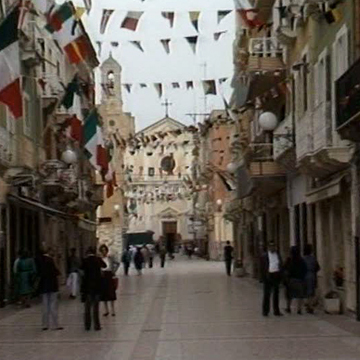Carloforte is located on the island of San Pietro, the second largest of the islands of the Sulcitan archipelago, S/W of Sardinia.
'YNSM or INOSIM (“island of sparrowhaws') was the ancient name of the island of San Pietro. The name, which probably followed that of the previous Phoenician settlement, appears in a Punic inscription from the third century BC found in Cagliari. It indicates a place of worship dedicated to the god Bashshamem located on the “island of sparrowhawks”, identified precisely with the Sulcitan island.
The island was probably also visited before the Levantine colonization. The stable settlement, documented by a large quantity of Phoenician ceramics, was probably born in the 8th century BC, as part of a process of occupation of strategic Sulcitan areas, aimed at controlling the access roads to the metal resources of the Iglesiente.
It is assumed that the area of the San Vittorio tower was at that time an islet, then connected to the larger island by a sandy bump: therefore, a favorable situation, to which was added, to the N/E of the town, a good harbor, as the nearby salt pans that have returned numerous fragments of commercial amphorae seem to document.
In an area just north of Carloforte, on the other hand, the Punic settlement was located, witnessed by the emerging remains of a building placed in a dominant position: perhaps, but it is not certain, the same temple of Bashshamem mentioned in the Cagliari inscription.
The structure shows a larger rectangular room and other smaller rooms that occupy a fairly large area. The walls, reduced to the basic base, are built with minute stones and large irregular blocks using the “pseudo frame” technique.
Still in the same area, the ruins of a fortified wall built with large square blocks have been recognized.
As for the burial areas, the Phoenician necropolis has yet to be located, while part of the Punic necropolis is currently visible between Viale Salvo D'Acquisento and the Giorgio Rombi climb, at the junction of Via Porta Casebba. These are chamber tombs dug out of vulcanite.
History of excavations
The interest in the archaeological evidence of the island began at the end of the 16th century, when Giovanni Francesco Fara mentioned some monuments. In the 18th century, after the island was resettled by the Ligurian fishermen of Tabarka, the German Giuseppe Fuos reported the existence of Punic chamber tombs. From that moment on, the island was the subject of discoveries and studies such as those of Della Marmora and Spano, until, in 1878, a student of Spano, Vincenzo Crespi, conducted the first official archaeological excavation campaign. In 1962 Ferruccio Barreca conducted a topographic exploration and Gennaro Pesce carried out an excavation test at the tower of San Vittorio, in S of Carloforte. At the same tower, in 1983, Paolo Bernardini and Raimondo Zucca located the Phoenician settlement.
Bibliography
R. Zucca, Insulae Sardinia and Corsica: the smaller islands of Sardinia and Corsica in ancient times, with the collaboration of P. Ruggeri, Rome, Carocci, 2003; P. Bernardini-R. Zucca, “Indigenous people and Phoenicians in the islands of San Vittorio and Mal Di Ventre”, in Actes du Congrès de Siliana (Siliana, 10 March 2004), in press.
How to get there
From Iglesias you reach the SS 130 and continue in the direction of Carbonia. The road crosses the SS 126, to be taken to the height of Bacu Abis. It turns to s., SP 82, for Portoscuso. The island of San Pietro and its major center, Carloforte, can be reached by two ferry lines from the port of Portovesme/Portoscuso and Calasetta, easily accessible from
Carbonia.
Content type:
Archaeological complex
Archaeology
Province: South Sardinia
Common: Carloforte
Macro Territorial Area: South Sardinia
POSTAL CODE: 09014
Address: Carloforte
Update
Where is it
Images
Video

Year : 2008
Results 2 of 48313
View All
Comments